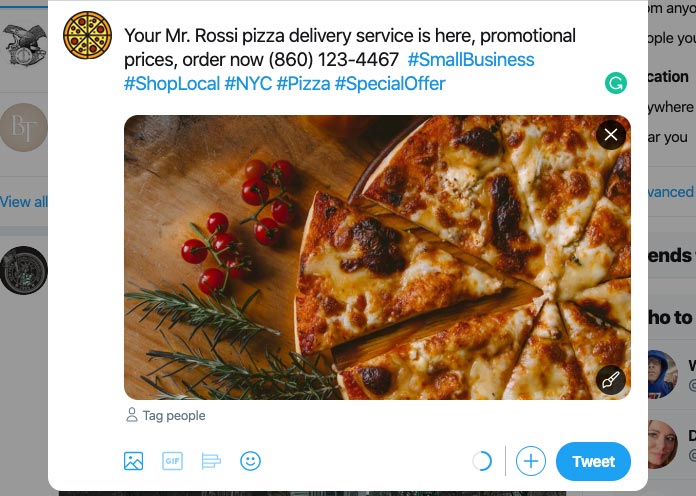The following blog post about hashtags strategy for small businesses is just a brief introduction to a subject. In this blog post, I have no intention to write about hashtags basics, tips, tricks, do’s and don’ts. So, let’s skip straight to the subject then.
Failing to rule own hashtags kingdom
Quite many small businesses fail to rule their hashtags kingdom despite none other aspirers to the throne. Unfortunately, they may not even notice it. There are a number of reasons why the king (You) does not sovereignly rule his territory.
Lack of decisive and proper action has led us to too many hashtags kingdoms without a ruler. The background to the situation we have today may lie in the fact that, at the beginning of the use of hashtags back in 2007, when introduced by Twitter, hashtags were considered to be actually “thing for nerds”. Suprinsligy hashtags rapidly become widespread throughout the platform in addition to being used by everyone.
Today, hashtags are used by many other social media platforms such as Instagram, Facebook, and YouTube. Literally, millions of personal and business users are posting their content with hashtags hoping to get exposure and engagement. Unfortunately, users tend to believe it’s all in the right combination of popular hashtags and their numbers.
I thought, having a different approach to this subject by creating a little story could be more fun to read as well as to have a better understanding. So, let’s explain the basics of hashtags strategy for a small business using an example.
A case of a small business user
Meet Mr. Rossi, who owns for more than two decades a pizza restaurant located somewhere along the Flatbush avenue in the Flatbush neighborhood, Brooklyn, New York City. The restaurant offers a wide range of pizzas as per Mr. Rossi’s own recipe. He’s proud of his regular guests, many of them first visited his restaurant when they were kids. He loves the neighborhood where he made his name, and the neighborhood loves him and his restaurant.
All these years Mr. Rossi has refused to start pizza delivery service as he strongly believed the pizza loses taste during the delivery process, and he couldn’t let that happen. However, he was aware of the fact that existing restaurant guests occasionally inquired about the possibility of ordering pizza and delivery to their address.
Fortunately for Mr. Rossi, his son, who recently joined him to help operate the restaurant was able to convince him to change his mind and start delivering pizzas. They decided to offer pizza delivery for the Flatbush neighborhood during and out of regular restaurant working hours.
After setting up all the logistics they were ready for a pizza delivery service kick-off. It was also the right time to start promoting a pizza delivery service on the restaurant’s social media platforms, Facebook, Instagram, and Twitter, operated by themselves.
A strategy doomed to fail
Now, let’s imaging Mr. Rossi and his son wanted to promote the starting of pizza delivery service along with a very special offer on their social media platforms.
The content for all three mentioned social media platforms should be a nice picture of a freshly made pizza along with one line of text and just a couple of hashtags.

The very first thing they could have done wrong is researching “hashtags for small business owners” and blindly implementing suggested hashtags in their social media posts.

Suggested general hashtags (#SmallBusiness, #SmallBiz, #ShopLocal #ShopLocal + #YourCity, State or Country. #Startup, #Startups) for small businesses wouldn’t do any good to the post content. All mentioned hashtags are too popular and widespread.
The second thing they could have done wrong is using hashtags such as #NYC, #NewYorkCity, #SpecialOffer, #Love, #Happynes, etc. Again, too popular, overused and widespread.
By using the above-mentioned hashtags Mr. Rossi and his son would not have properly targeted their guests. Their social media post would have competed with millions of other posts and the good result would have been hard to expect.
This strategy could be described as fighting for kingdoms you really don’t have an interest in, neither the power to control or better to say to serve.
A strategy with a promising result
The right path to a promising result for Mr. Rossi and his son is easier than it seems to. What they first should do is to make a research on available local hashtags. By local, I really mean Flatbush neighborhood related.
For this example, I quickly found a couple of hashtags for posts on Instagram that are absolutely must-have in a post such as #flatbush #flatbushbrooklyn, #flatbushavenu, #brooklyncolledge, #flatbushrestaurants, and many others, specifically related to the neighborhood served by Mr. Rossis’s restaurant.

This strategy could be described as fighting for the throne in your kingdom. It doesn’t matter if there are other aspirants to the throne, if not, even better. In any case, in this way, you will clearly show your presence in the neighborhood or territory that interests you.
Sure, one should pay attention to the content length and number of hashtags within the social media post. More on that subject can be found on numerous posts related to good practices on various social media platforms.
Again, if you want to master your hashtags strategy there is a lot more to think about, this was just an introduction. For instance, testing for new hashtags, keeping track and analyzing hashtag use will help you even further.
Please, let me know if this blog post helped anyone. You can also post your question in reply to this post. I’ll be happy to reply or provide help if needed.
